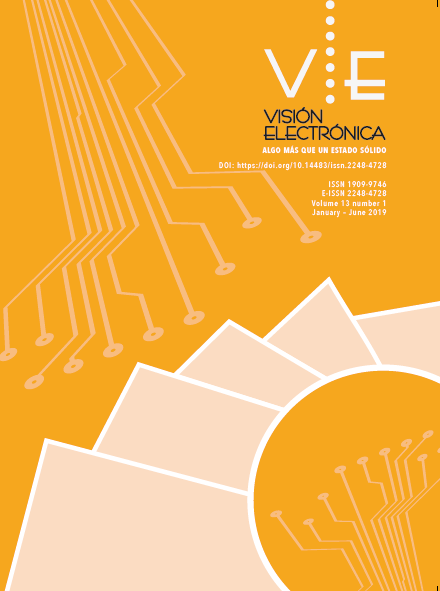DOI:
https://doi.org/10.14483/22484728.14410Published:
2019-01-31Issue:
Vol. 13 No. 1 (2019)Section:
A Case-Study VisionModelling of the carotid artery
Modelamiento de la arteria carótida
Keywords:
Carotid artery, Characteristics, Electrical circuit, Laws of Poiseuille, Modelling, Pressure (en).Keywords:
Arteria carótida, Características, Circuito eléctrico, Leyes de Poiseuille, Modelado, Presión (es).Downloads
Abstract (en)
This study presents a modelling for the carotid artery that allows to analyze the theoretical behavior of pressure, flow and arterial volume in it, from the variation of both physical and physiological characteristics, such as: the thickness and length of the vessel blood, the viscosity and density of blood; determinants in the study of the normal functionality of the artery. The model of the arterial vessel –an adaptation of the Windkessel model of three elements, reported by Westerhof and Stergiopulos–, consists of an electrical circuit composed of passive RLC elements. The arterial segment was analyzed by mathematical and computational tools, relating Poiseuille's laws and electric laws. The pressure, flow and volume curves were obtained when changes occurred in the measurable characteristics of the carotid artery, in order to facilitate the medical interpretation of possible pathologies related to these changes.
Abstract (es)
Este estudio presenta un modelado para la arteria carótida que permite analizar el comportamiento teórico de la presión, el flujo y el volumen arterial en ella, a partir de la variación de características tanto físicas como fisiológicas tales como: el espesor y longitud del vaso sanguíneo, la viscosidad y densidad de la sangre; determinantes en el estudio de la funcionalidad normal de tal arteria. El modelo del vaso arterial, –una adaptación del modelo de Windkessel de tres elementos reportado por Westerhof y Stergiopulos–, consiste en un circuito eléctrico compuesto de elementos pasivos RLC. El segmento arterial se analizó mediante herramientas matemáticas y computacionales, relacionando las leyes de Poiseuille y las leyes eléctricas. Se obtuvieron las curvas de presión, flujo y volumen, cuando ocurrían cambios en las características medibles de la arteria carótida, con el fin de facilitar la interpretación médica de posibles patologías relacionadas con estos cambios.
References
G. B. Bradac, “Cerebral Angiography Normal Anatomy and Vascular Pathology: Carotid Artery (CA)”, Berlin: Springer-Verlag, 2011, pp 5-19, https://doi.org/10.1007/978-3-642-15678-6_2
M. J. Cipolla, “The Cerebral Circulation, Chapter 2, Anatomy and Ultrastructure”, San Rafael: Morgan & Claypool Life Sciences, 2009.
J. R. Fortuñoa, J. Perendreu, J. Falco, D. Canovas and J. Branera, “Estenosis carotídea: cómo se diagnostica y se trata adecuadamente”, Radiología, vol. 48, no. 3, 2006, pp. 119-36, https://doi.org/10.1016/S0033-8338(06)73143-5
J. S. Milner, J. A. Moore, B. K. Rutt and D. A. Steinman, “Hemodynamics of human carotid artery bifurcations: Computational studies with models reconstructed from magnetic resonance imaging of normal subjects”, Journal of Vascular Surgery, vol. 28, no. 1, 1998, pp. 143-155, https://doi.org/10.1016/S0741-5214(98)70210-1
R. M. Menchón, J. L. Sancho and A. Bueno, “Early-stage atherosclerosis detection using deep learning over carotid ultrasound images”, Applied Soft Computing, vol. 49, 2016, pp 616–628, https://doi.org/10.1016/j.asoc.2016.08.055
S. Z. Zhao et al., “Blood flow and vessel mechanics in a physiologically realistic model of a human carotid arterial bifurcation”, Journal of Biomechanics, vol. 33, no. 8, 2000, pp. 975-984. https://doi.org/10.1016/S0021-9290(00)00043-9
Y. Ҫinar, A. M. Şenyol and K Duman, “Blood Viscosity and Blood Pressure: Role of Temperature and Hyperglycemia”, American Journal of Hypertension, vol. 14, no. 5, 2001, pp 432-438.
W. A. Riley, R. W. Barnes, G. W. Evans and G. L. Burke, “Ultrasonic Measurement of the Elastic Modulus of the Common Carotid Artery the Atherosclerosis Risk in Communities (ARIC) Study”, Stroke, vol. 23, no. 7, 1992, pp 952-956, https://doi.org/10.1161/01.STR.23.7.952
R. Sani, S. Vashisth and R. Bhatia, “Classification of Pressure Gradient of Human Common Carotid Artery and Ascending Aorta on the Basis of Age and Gender”, International Journal of Computer Applications, vol. 145, no. 1, 2016.
F. J. Gijsen, F. N. van de Vosse and J. D. Janssen, “The influence of the non-Newtonian properties of blood on the flow in large arteries: steady flow in a carotid bifurcation model”, Journal of Biomechanics, vol. 32, no. 6, 1999, pp. 601-608. https://doi.org/10.1016/S0021-9290(99)00015-9
N. Westerhof and N. Stergiopulos, “Models of the arterial tree”, Stud Health Technol Inform, vol. 71, 2000, pp. 65-77.
T. Kenner, “The measurement of blood density and its meaning”, Basic Research in Cardiology, vol. 84, no. 2, 1989, pp. 111-124, https://doi.org/10.1007/BF01907921
Y. Ҫinar, G. Demir, M. Paç and A. B. Cinar, “Effect of Hematocrit on Blood Pressure Via Hyperviscosity”, American Journal of Hypertension, vol. 12, no. 7, 1999, pp. 739-743, https://doi.org/10.1016/S0895-7061(99)00011-4
L. Guillevin and T. Dörner, “Vasculitis: mechanisms involved and clinical manifestations”, Arthritis Research & Therapy, vol. 9, no. 2, 2007, pp. 1-9. https://doi.org/10.1186/ar2193


1.png)




.jpg)





